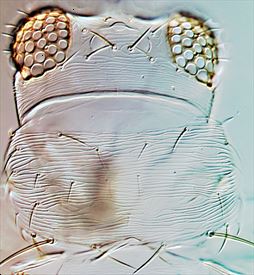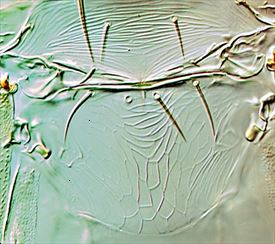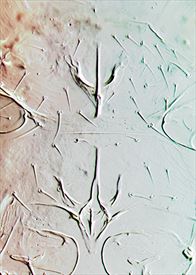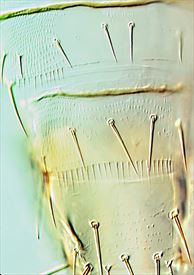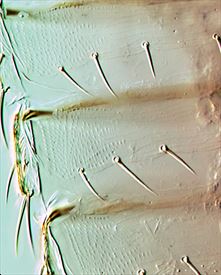Distinguishing features
Both sexes fully winged. Female yellow, antecostal ridges on tergites and sternites dark; fore wings shaded near base but pale distally; antennal segment I pale, II–VIII darker. Head with vertex closely striate, ocellar region with several transverse lines; ocellar setae pair III about twice as long as diameter of one posterior ocellus, close together between midpoints of posterior ocelli; two pairs of post-ocular setae. Pronotum with transverse striae not closely spaced, distance between lines about equal to diameter of a discal setal pore; posteromarginal setae S2 50–65 microns long, more than twice diameter of antennal segment II. Metanotal reticulation arcuate anteriorly but almost equiangular on posterior half; median setae close to anterior margin. Fore wing clavus with 4 marginal setae; first vein with about 10 setae; second vein with 2–3 setae; all posteromarginal fringe cilia straight. Tergite I without long discal setae, III–V median setae longer than distance between bases; tergal microtrichial fields with 4–6 discal setae; VIII with discal microtrichia anteromedially, posteromarginal comb complete; IX without discal microtrichia. Sternites III–VI with microtrichial fields extending just mesad of setae S2.
Male similar to female but smaller, tergite IX without drepanae.
Related species
The genus Scirtothrips comprises almost 100 described species worldwide, with 21 species known from Australia, most of which are endemics to this continent. These species all have the lateral thirds of the abdominal tergites covered in closely spaced rows of fine microtrichia, and in many species the sternites also bear similar microtrichia. S. inermis is similar to S. dobroskyi from northern parts of Australia in having unusually long posteromarginal setae S2 on the pronotum, and ocellar setae pair III are also long. S. inermis usually has at least one more discal seta on the tergal microtrichial fields than in other members of the genus.
Biological data
This polyphagous species feeds and breeds on young leaves. In New Zealand adults have been taken from Viburnum sp. [Caprifoliaceae], Gerbera sp. [Asteraceae], but on Norfolk Island large numbers were found on Citrus and Peach leaves (Mound & Wells, 2015).
Distribution data
The country of origin of this species remains unknown, but it is introduced to New Zealand (AK, CL, WN /SD). It is widespread but apparently not common around the world, and recorded from Canary Islands, California, Norfolk Island, and southern Australia.
Family name
THRIPIDAE, THRIPINAE
Species name
Scirtothrips inermis Priesner
Original name and synonyms
Scirtothrips inermis Priesner, 1933: 186
References
Hoddle MS & Mound LA (2003) The genus Scirtothrips in Australia (Insecta, Thysanoptera, Thripidae). Zootaxa 268: 1–40.
Mound LA & Wells A (2015) Endemics and adventives: Thysanoptera (Insecta) Biodiversity of Norfolk, a tiny Pacific Island. Zootaxa 3964 (2): 183–210.

